Alternating group
In mathematics, an alternating group is the group of even permutations of a finite set. The alternating group on a set of n elements is called the alternating group of degree n, or the alternating group on n letters and denoted by An or Alt(n).
| Algebraic structure → Group theory Group theory |
|---|
 |
|
|
Infinite dimensional Lie group
|
Basic properties
For n > 1, the group An is the commutator subgroup of the symmetric group Sn with index 2 and has therefore n! / 2 elements. It is the kernel of the signature group homomorphism sgn : Sn → {1, −1} explained under symmetric group.
The group An is abelian if and only if n ≤ 3 and simple if and only if n = 3 or n ≥ 5. A5 is the smallest non-abelian simple group, having order 60, and the smallest non-solvable group.
The group A4 has the Klein four-group V as a proper normal subgroup, namely the identity and the double transpositions { (), (12)(34), (13)(24), (14)(23) }, that is the kernel of the surjection of A4 onto A3 = C3. We have the exact sequence V → A4 → A3 = C3. In Galois theory, this map, or rather the corresponding map S4 → S3, corresponds to associating the Lagrange resolvent cubic to a quartic, which allows the quartic polynomial to be solved by radicals, as established by Lodovico Ferrari.
Conjugacy classes
As in the symmetric group, any two elements of An that are conjugate by an element of An must have the same cycle shape. The converse is not necessarily true, however. If the cycle shape consists only of cycles of odd length with no two cycles the same length, where cycles of length one are included in the cycle type, then there are exactly two conjugacy classes for this cycle shape (Scott 1987, §11.1, p299).
Examples:
- The two permutations (123) and (132) are not conjugates in A3, although they have the same cycle shape, and are therefore conjugate in S3.
- The permutation (123)(45678) is not conjugate to its inverse (132)(48765) in A8, although the two permutations have the same cycle shape, so they are conjugate in S8.
Relation with symmetric group
- See Symmetric group.
Generators and relations
An is generated by 3-cycles, since 3-cycles can be obtained by combining pairs of transpositions. This generating set is often used to prove that An is simple for n ≥ 5.
Automorphism group
For n > 3, except for n = 6, the automorphism group of An is the symmetric group Sn, with inner automorphism group An and outer automorphism group Z2; the outer automorphism comes from conjugation by an odd permutation.
For n = 1 and 2, the automorphism group is trivial. For n = 3 the automorphism group is Z2, with trivial inner automorphism group and outer automorphism group Z2.
The outer automorphism group of A6 is the Klein four-group V = Z2 × Z2, and is related to the outer automorphism of S6. The extra outer automorphism in A6 swaps the 3-cycles (like (123)) with elements of shape 32 (like (123)(456)).
Exceptional isomorphisms
There are some exceptional isomorphisms between some of the small alternating groups and small groups of Lie type, particularly projective special linear groups. These are:
- A4 is isomorphic to PSL2(3)[1] and the symmetry group of chiral tetrahedral symmetry.
- A5 is isomorphic to PSL2(4), PSL2(5), and the symmetry group of chiral icosahedral symmetry. (See[1] for an indirect isomorphism of PSL2(F5) → A5 using a classification of simple groups of order 60, and here for a direct proof).
- A6 is isomorphic to PSL2(9) and PSp4(2)'.
- A8 is isomorphic to PSL4(2).
More obviously, A3 is isomorphic to the cyclic group Z3, and A0, A1, and A2 are isomorphic to the trivial group (which is also SL1(q) = PSL1(q) for any q).
Examples S4 and A4
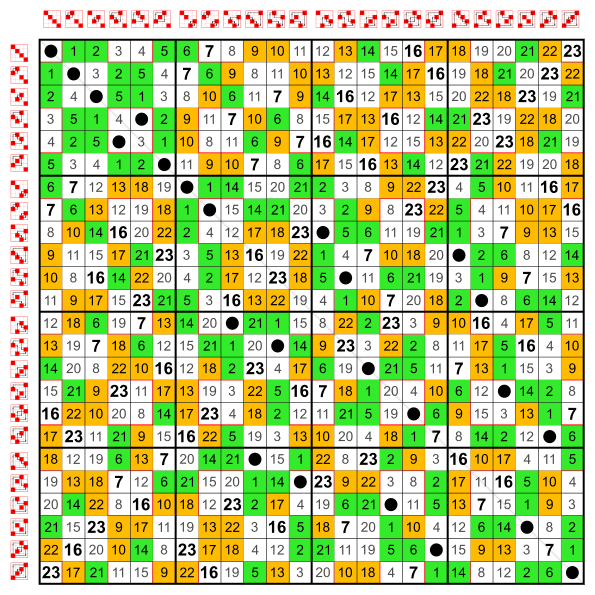 Cayley table of the symmetric group S4 The odd permutations are colored: Transpositions in green and 4-cycles in orange | 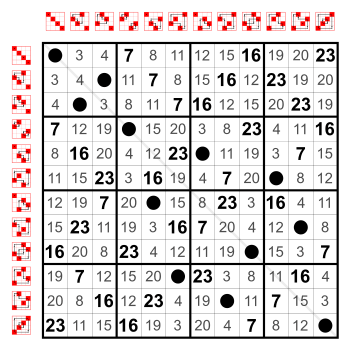 Cayley table of the alternating group A4 Elements: The even permutations (the identity, eight 3-cycles and three double-transpositions (double transpositions in boldface)) Subgroups: .svg.png) .svg.png) .svg.png) .svg.png) .svg.png) |
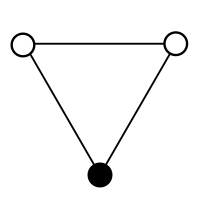 A3 = Z3 (order 3) |
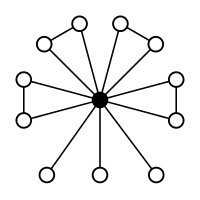 A4 (order 12) |
 A4 × Z2 (order 24) |
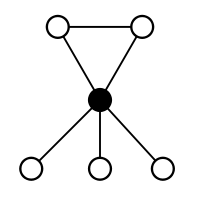 S3 = Dih3 (order 6) |
 S4 (order 24) |
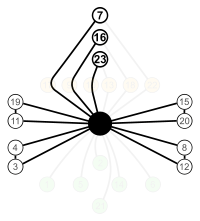 A4 in S4 on the left |
Example A5 as a subgroup of 3-space rotations
.gif)
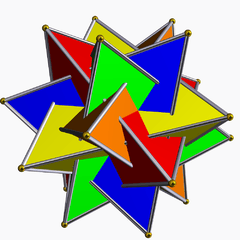
is the group of isometries of a dodecahedron in 3 space, so there is a representation
In this picture the vertices of the polyhedra represent the elements of the group, with the center of the sphere representing the identity element. Each vertex represents a rotation about the axis pointing from the center to that vertex, by an angle equal to the distance from the origin, in radians. Vertices in the same polyhedron are in the same conjugacy class. Since the conjugacy class equation for is 1+12+12+15+20=60, we obtain four distinct (nontrivial) polyhedra.
The vertices of each polyhedron are in bijective correspondence with the elements of its conjugacy class, with the exception of the conjugacy class of (2,2)-cycles, which is represented by an icosidodecahedron on the outer surface, with its antipodal vertices identified with each other. The reason for this redundancy is that the corresponding rotations are by radians, and so can be represented by a vector of length in either of two directions. Thus the class of (2,2)-cycles contains 15 elements, while the icosidodecahedron has 30 vertices.
The two conjugacy classes of twelve 5-cycles in are represented by two icosahedra, of radii and , respectively. The nontrivial outer automorphism in interchanges these two classes and the corresponding icosahedra.
Subgroups
A4 is the smallest group demonstrating that the converse of Lagrange's theorem is not true in general: given a finite group G and a divisor d of |G|, there does not necessarily exist a subgroup of G with order d: the group G = A4, of order 12, has no subgroup of order 6. A subgroup of three elements (generated by a cyclic rotation of three objects) with any distinct nontrivial element generates the whole group.
For all n > 4, An has no nontrivial (that is, proper) normal subgroups. Thus, An is a simple group for all n > 4. A5 is the smallest non-solvable group.
Group homology
The group homology of the alternating groups exhibits stabilization, as in stable homotopy theory: for sufficiently large n, it is constant. However, there are some low-dimensional exceptional homology. Note that the homology of the symmetric group exhibits similar stabilization, but without the low-dimensional exceptions (additional homology elements).
H1: Abelianization
The first homology group coincides with abelianization, and (since is perfect, except for the cited exceptions) is thus:
- for ;
- ;
- ;
- for .
This is easily seen directly, as follows. is generated by 3-cycles – so the only non-trivial abelianization maps are since order 3 elements must map to order 3 elements – and for all 3-cycles are conjugate, so they must map to the same element in the abelianization, since conjugation is trivial in abelian groups. Thus a 3-cycle like (123) must map to the same element as its inverse (321), but thus must map to the identity, as it must then have order dividing 2 and 3, so the abelianization is trivial.
For , is trivial, and thus has trivial abelianization. For and one can compute the abelianization directly, noting that the 3-cycles form two conjugacy classes (rather than all being conjugate) and there are non-trivial maps (in fact an isomorphism) and
H2: Schur multipliers
The Schur multipliers of the alternating groups An (in the case where n is at least 5) are the cyclic groups of order 2, except in the case where n is either 6 or 7, in which case there is also a triple cover. In these cases, then, the Schur multiplier is (the cyclic group) of order 6.[2] These were first computed in (Schur 1911).
- for ;
- for ;
- for ;
- for .
Notes
- Robinson (1996), p. 78
- Wilson, Robert (October 31, 2006), "Chapter 2: Alternating groups", The finite simple groups, 2006 versions, archived from the original on May 22, 2011, 2.7: Covering groups
References
- Robinson, Derek John Scott (1996), A course in the theory of groups, Graduate texts in mathematics, 80 (2 ed.), Springer, ISBN 978-0-387-94461-6
- Schur, Issai (1911), "Über die Darstellung der symmetrischen und der alternierenden Gruppe durch gebrochene lineare Substitutionen", Journal für die reine und angewandte Mathematik, 139: 155–250, doi:10.1515/crll.1911.139.155
- Scott, W.R. (1987), Group Theory, New York: Dover Publications, ISBN 978-0-486-65377-8